Khosrow II
Khosrow II (Chosroes II in classical sources; Middle Persian: Husrō(y)), also known as Khosrow Parviz (New Persian: خسرو پرویز, "Khosrow the Victorious"), was the last great Sasanian king (shah) of Iran, ruling from 590 to 628, with an interruption of one year.[1]
| Khosrow II 𐭧𐭥𐭮𐭫𐭥𐭣𐭩 | |
|---|---|
| King of Kings of Iranians and non-Iranians Aparvēz | |
 Gold coin of Khosrow II, minted in 611 | |
| Shahanshah of the Sasanian Empire | |
| 1st Reign | 590 |
| Predecessor | Hormizd IV |
| Successor | Bahram Chobin |
| 2nd Reign | 591 – 25 February 628 |
| Predecessor | Bahram Chobin |
| Successor | Kavad II |
| Born | c. 570 |
| Died | 28 February 628 (aged 57–58) Ctesiphon |
| Consort | |
| Issue | See below |
| House | House of Sasan |
| Father | Hormizd IV |
| Mother | Unnamed Ispahbudhan noblewoman |
| Religion | Zoroastrianism |
He was the son of Hormizd IV (reigned 579–590) and the grandson of Khosrow I (reigned 531–579). Khosrow II was the last king of Iran to have a lengthy reign before the Muslim conquest of Iran, which began five years after his execution. He lost his throne, then recovered it with the help of the Byzantine emperor Maurice, and, a decade later, went on to emulate the feats of the Achaemenids, conquering the rich Roman provinces of the Middle East; much of his reign was spent in wars with the Byzantine Empire and struggling against usurpers such as Bahram Chobin and Vistahm.
After the Byzantines killed Maurice, Khosrow II began a war in 602 against the Byzantines. Khosrow II's forces captured much of the Byzantine Empire's territories, earning the king the epithet "the Victorious". A siege of the Byzantine capital of Constantinople in 626 was unsuccessful, and Heraclius, now allied with Turks, started a successful risky counterattack deep into Persia's heartland. Supported by the feudal families of the empire, Khosrow II's imprisoned son Sheroe (Kavad II) imprisoned and killed Khosrow II. This led to a civil war and interregnum in the empire and the reversal of all Sasanian gains in the war against the Byzantines.
In works of Persian literature such as the Shahnameh and Khosrow and Shirin, a famous tragic romance by Nizami Ganjavi (1141–1209), a highly elaborated fictional version of Khosrow's life made him one of the greatest heroes of the culture, as much as a lover as a king. Khosrow and Shirin tells the story of his love for the Aramean/Roman princess Shirin, who becomes his queen after a lengthy courtship strewn with mishaps and difficulties.
Name
"Khosrow" is the New Persian variant of his name used by scholars; his original name was Middle Persian, Husraw, itself derived from Avestan Haosrauuah ("he who has good fame").[2] The name is transliterated in Greek as Chosroes and in Arabic as Kisra.[3]
Background
Khosrow II was born in c. 570; he was the son of Hormizd IV and an unnamed noblewoman from the House of Ispahbudhan, one of the Seven Great Houses of Iran.[1] Her brothers, Vinduyih and Vistahm, were to have a profound influence in Khosrow II's early life.[1] Khosrow's paternal grandfather was the famed Sasanian shah Khosrow I Anushirvan (r. 531–579), whilst his paternal grandmother was the daughter of the khagan of the Khazars.[4] Khosrow is first mentioned in the 580s, when he was at Partaw, the capital of Caucasian Albania. During his stay there, he served as the governor of the kingdom, and managed to put an end to the Kingdom of Iberia and make it into a Sasanian province.[1] Furthermore, Khosrow II also served as the governor of Arbela in Mesopotamia around this period.[5]
Accession
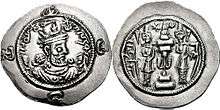
In 590, Hormizd IV had his prominent general Bahram Chobin disgraced and dismissed. Bahram, infuriated by Hormizd's actions, responded by rebelling, and due to his noble status and great military knowledge, was joined by his soldiers and many others. He then appointed a new governor for Khorasan, and afterwards set for the Sasanian capital of Ctesiphon.[6] Meanwhile, Hormizd tried to come to terms with his brothers-in-law Vistahm and Vinduyih, "who equally hated Hormizd".[6] Hormizd shortly had Vinduyih imprisoned, while Vistahm managed to flee from the court. After a short period of time, a palace coup under the two brothers occurred in Ctesiphon, which resulted in the blinding of Hormizd and the accession of Khosrow II. The two brothers shortly had Hormizd killed. Nevertheless, Bahram continued his march to Ctesiphon, now with the pretext of claiming to avenge Hormizd.[6][7]
Khosrow then took a carrot and stick attitude, and wrote a message to Bahram, stressing his rightful claim to the Sasanian kingship: "Khosrow, kings of kings, ruler over the ruling, lord of the peoples, prince of peace, salvation of men, among gods the good and eternally living man, among men the most esteemed god, the highly illustrious, the victor, the one who rises with the sun and who lends the night his eyesight, the one famed through his ancestors, the king who hates, the benefactor who engaged the Sasanians and saved the Iranians their kingship—to Bahram, the general of the Iranians, our friend.... We have also taken over the royal throne in a lawful manner and have no upset Iranian customs.... We have so firmly decided not to take off the diadem that we even expected to rule over other worlds, if this were possible.... If you wish your welfare, think about what is to be done."[8]
Flight
.jpg)
Bahram, however, ignored his warning—a few days later, he reached the Nahrawan Canal near Ctesiphon, where he fought Khosrow's men, who were heavily outnumbered, but managed to hold Bahram's men back in several clashes. However, Khosrow's men eventually began losing their morale, and were in the end defeated by Bahram's forces. Khosrow, together with his two uncles, his wives, and a retinue of 30 nobles, thereafter fled to Byzantine territory, while Ctesiphon fell to Bahram.[1] Bahram declared himself king of kings in the summer of 590, asserting that the first Sasanian king Ardashir I (r. 224–242) had usurped the throne of the Arsacids, and that he now was restoring their rule.[6]
Bahram tried to support his cause with the Zoroastrian apocalyptic belief that by the end of Zoroaster's millennium, chaos and destructive wars with the Hephthalites/Huns and the Romans occurs and then a savior would appear. Indeed, the Sasanians had misidentified Zoroaster's era with that of the Seleucids (312 BC), which put Bahram's life almost at the end of Zoroaster's millennium, he was therefore hailed by many as the promised savior Kay Bahram Varjavand.[6] Bahram was to re-establish the Arsacid Empire and commenced a new millennium of dynastic rule. He started minting coins, where he is on the front imitated as an exalted figure, bearded and wearing a crenellation-shaped crown with two crescents of the moon, whilst the reverse shows the traditional fire altar flanked by two attendants.[6] Regardless, many nobles and priests still chose to side with the inexperienced and less dominant Khosrow II.[6]
In order to get the attention of the Byzantine emperor Maurice (r. 582–602), Khosrow II went to Syria, and sent a message to the Sasanian occupied city of Martyropolis to stop their resistance against the Byzantines, but with no avail.[9] He then sent a message to Maurice, and requested his help to regain the Sasanian throne, which the Byzantine emperor agreed with; in return, the Byzantines would re-gain sovereignty over the cities of Amida, Carrhae, Dara and Martyropolis. Furthermore, Iran was required to stop intervening in the affairs of Iberia and Armenia, effectively ceding control of Lazistan to the Byzantines.[1]
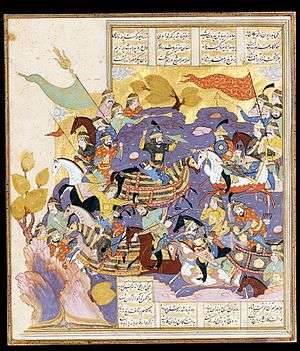
Return to Iran
In 591, Khosrow moved to Constantia and prepared to invade Bahram's territories in Mesopotamia, while Vistahm and Vinduyih were raising an army in Adurbadagan under the observation of the Byzantine commander John Mystacon, who was also raising an army in Armenia. After some time, Khosrow, along with the Byzantine commander of the south, Comentiolus, invaded Mesopotamia. During this invasion, Nisibis and Martyropolis quickly defected to them,[1] and Bahram's commander Zatsparham was defeated and killed.[10] One of Bahram's other commanders, Bryzacius, was captured in Mosil and had his nose and ears cut off, and was thereafter sent to Khosrow, where he was killed.[11][12] Khosrow II and the Byzantine general Narses then penetrated deeper into Bahram's territory, seizing Dara and then Mardin in February, where Khosrow was re-proclaimed king.[10] Shortly after this, Khosrow sent one of his Iranian supporters, Mahbodh, to capture Ctesiphon, which he managed to accomplish.[13]
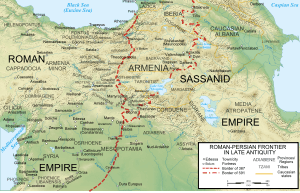
At the same time a force of 8,000 Iranians under Vistahm and Vinduyih and 12,000 Armenians under Mushegh II Mamikonian invaded Adurbadagan.[6] Bahram tried to disrupt the force by writing a letter to Mushegh II, the letter said: "As for you Armenians who demonstrate an unseasonable loyalty, did not the house of Sasan destroy your land and sovereignty? Why otherwise did your fathers rebel and extricate themselves from their service, fighting up until today for your country?"[14] Bahram in his letter promised that the Armenians would become partners of the new Iranian empire ruled by a Parthian dynastic family if he accepted his proposal to betray Khosrow II.[15] Mushegh, however, rejected the offer.[15]
Bahram was then defeated at the Battle of Blarathon, forcing him to flee with 4,000 men eastwards. He marched towards Nishapur, where he defeated a pursuing army as well as an army led by a Karenid nobleman at Qumis. Constantly troubled, he finally arrived in Fergana[6] where he was received honorably by the Khagan of the Turks.[7] Bahram entered his service, and was appointed as a commander in the army, achieving further military accomplishments there.[16][6] Khosrow II, however, could not feel safe as long as Bahram lived, and succeeded in having him assassinated.[6] The assassination was reportedly achieved out through distribution of presents and bribes between the members of the Turkic royal family, notably the queen.[16]
Second reign
Rebellion of Vistahm
After his victory, Khosrow rewarded his uncles with high positions: Vinduyih became treasurer and first minister and Vistahm received the post of spahbed of the East, encompassing Tabaristan and Khorasan, which was the traditional homeland of the Ispahbudhan.[17][18] Soon, however, Khosrow changed his intentions: trying to disassociate himself from his father's murder, he decided to execute his uncles. The Sasanian monarchs' traditional mistrust of over-powerful magnates and Khosrow's personal resentment of Vinduyih's patronising manner certainly contributed to this decision. Vinduyih was soon put to death, according to a Syriac source captured while trying to flee to his brother in the East.[17][19]
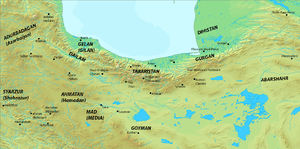
At the news of his brother's murder, Vistahm rose in open revolt. According to Dinawari, Vistahm sent a letter to Khosrow announcing his claim to the throne through his Parthian (Arsacid) heritage: "You are not worthier to rule than I am. Indeed, I am more deserving on account of my descent from Darius, son of Darius, who fought Alexander. You Sasanians deceitfully gained superiority over us [the Arsacids] and usurped our right, and treated us with injustice. Your ancestor Sasan was no more than a shepherd." Vistahm's revolt, like Bahrams's shortly before, found support and spread quickly. Local magnates as well as the remnants of Bahram Chobin's armies flocked to him, especially after he married Bahram's sister Gordiya. Vistahm repelled several loyalist efforts to subdue him, and he soon held sway in the entire eastern and northern quadrants of the Iranian realm, a domain stretching from the Oxus river to the region of Ardabil in the west. He even campaigned in the east, where he subdued two Hephthalite princes of Transoxiana, Shaug and Pariowk.[17][20] The date of Vistahm's uprising is uncertain. From his coinage, it is known that his rebellion lasted for seven years. The commonly accepted dates are ca. 590–596, but some scholars like J.D. Howard–Johnston and P. Pourshariati push its outbreak later, in 594/5, to coincide with the Armenian Vahewuni rebellion.[21]
As Vistahm began to threaten Media, Khosrow sent several armies against his uncle, but failed to achieve a decisive result: Vistahm and his followers retreated to the mountainous region of Gilan, while several Armenian contingents of the royal army rebelled and defected to Vistahm. Finally, Khosrow called upon the services of the Armenian Smbat Bagratuni, who engaged Vistahm near Qumis. During the battle, Vistahm was murdered by Pariowk at Khosrow's urging (or, according to an alternative account, by his wife Gordiya). Nevertheless, Vistahm's troops managed to repel the royal army at Qumis, and it required another expedition by Smbat in the next year to finally end the rebellion.[17][22]
Music during the reign of Khosrow II
Khosrow II's reign was considered a golden age in music. Before Khosrow II there were many other Sasanian kings that showed particular interest in music, like Khosrow I, Bahram Gur, and even Ardashir I. Notable musicians during the reign of Khosrow II were Barbad (Khosrow's favorite court musician), Bamshad, Sarkash, and Nagisa.
Religious policy
Khosrow II married a Christian named Shirin, whose son Mardanshah he wanted to succeed to the throne. Khosrow's relationship to Christianity was complicated: his wife Shirin was Christian, and so was Yazdin, his minister of finance.[23] During his reign there was constant conflict between Monophysite and Nestorian Christians. Khosrow favored the Monophysites, and ordered all his subjects to adhere to Monophysitism, perhaps under the influence of Shirin and the royal physician Gabriel of Sinjar, who both supported this faith. Khosrow also dispensed money or gifts to Christian shrines.[24] Khosrow's great tolerance to Christianity and friendship with the Christian Byzantines even made some Armenian writers think that Khosrow was a Christian.[24] His positive policy toward Christians (which, however, was probably politically motivated) made him unpopular with the Zoroastrian priests, and also made Christianity greatly spread around the Sasanian Empire.[25]
However, Khosrow also paid attention to the Zoroastrians, and built various fire temples. But this did not help the Zoroastrian church, which was in a heavy decline during the reign of Khosrow, which, in the words of Richard N. Frye, "was noted for its devotion to luxury more than its devotion to thought."[26]
Deposition of the Lakhmid king
In 600, Khosrow II executed Al-Nu'man III, King of the Lakhmids of Al-Hira, presumably because of the Arab king's refusal to give him his daughter al-Ḥurqah in marriage and insulting Persian women.[27] Afterwards the central government took over the defense of the western frontiers to the desert, and the buffer state of the Lakhmids vanished. This ultimately facilitated the Muslim Caliphs' invasion and conquest of Lower Iraq, less than a decade after Khosrow's death.[28]
Initial invasion of the Byzantine Empire
.svg.png)
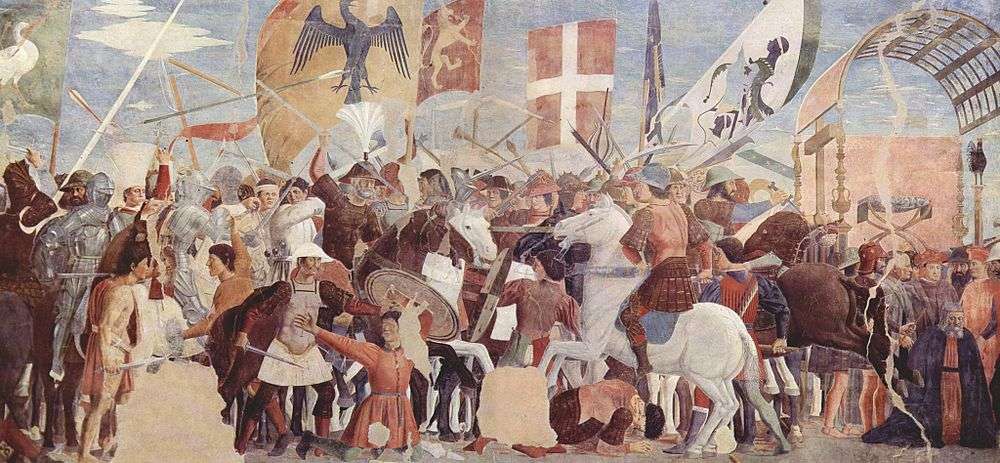
Toward the beginning of his reign, Khosrow II had good relations with the Byzantines. However, when in 602 Emperor Maurice was murdered by his General Phocas (602–610), who usurped the Roman (Byzantine) throne, Khosrow launched an offensive against Constantinople: ostensibly to avenge Maurice's death, but his aim clearly included the annexation of as much Byzantine territory as was feasible.[1] Khosrow II, along with Shahrbaraz and his other best generals, quickly captured Dara and Edessa in 604, and recaptured lost territory in the north, which made the Sasanian–Byzantine borders go back to the pre-591 frontier before Khosrow gave Maurice territory in return for military aid against Bahram Chobin. After having reclaimed lost territory, Khosrow withdrew from the battlefield and handed military operations to Shahrbaraz and Shahin Vahmanzadegan. The Sasanian armies then invaded and plundered Syria and Asia Minor, and in 608 advanced into Chalcedon.
In 610, Heraclius,revolted against Phocas and killed him, crowning himself as Emperor of the Byzantine Empire. He then tried to negotiate peace with Khosrow II by sending diplomats to his court. Khosrow, however, rejected their offer and said: "That kingdom belongs to me, and I shall enthrone Maurice's son, Theodosius, as emperor. [As for Heraclius], he went and took the rule without our order and now offers us our own treasure as gifts. But I shall not stop until I have him in my hands." Khosrow then had the diplomats executed.[29]
In 613 and 614, General Shahrbaraz besieged and captured Damascus and Jerusalem, and the True Cross was carried away in triumph. Soon afterwards, Shahin marched through Anatolia, defeating the Byzantines numerous times; he conquered Egypt in 618. The Byzantines could offer but little resistance, as they were torn apart by internal dissensions, and pressed by the Avars and Slavs, who were invading the Empire from across the Danube River. In 622/3, Rhodes and several other islands in the eastern Aegean fell to the Sasanians, threatening a naval assault on Constantinople.[30][31][32][33] Such was the despair in Constantinople that Heraclius considered moving the government to Carthage in Africa.[34]
Turko-Hephthalite invasion
In ca. 606/607, Khosrow recalled Smbat IV Bagratuni from Sasanian Armenia and sent him to repel the Turko-Hephthalites, who had raided as far as Spahan in central Iran. Smbat, with the aid of an Iranian prince named Datoyean, repelled the Turko-Hephthalites from Iran, and plundered their domains in eastern Khorasan, where Smbat is said to have killed their king in single combat.[35] Khosrow then gave Smbat the honorific title Khosrow Shun ("the Joy or Satisfaction of Khosrow"),[35] while his son Varaztirots II Bagratuni received the honorific name Javitean Khosrow ("Eternal Khosrow").[35][36]
Sebeos describes the event as:
He [Khosrow] ordered that a huge elephant be adorned and brought to the chamber. He commanded that [Smbat's son] Varaztirots' (who was called Javitean Khosrow by the king), be seated atop [the elephant]. And he ordered treasures scattered on the crowd. He wrote [to Smbat] a hrovartak [expressing] great satisfaction and summoned him to court with great honor and pomp. [Smbat] died in the 28th year of [Khosrow's] reign [618–19].[37]
Invasion of the Byzantine Empire
In 622, despite the major progress the Sasanians were making in the area of the Aegean Sea, the Byzantine Emperor Heraclius was able to take the field with a powerful force. In 624, he advanced into northern Adurbadagan, where he was welcomed by Farrukh Hormizd and his son Rostam Farrokhzad who had rebelled against Khosrow.[38] Heraclius then began sacking several cities and temples, including the Adur Gushnasp temple.
Several years later, in 626, he captured Lazistan (Colchis). Later that same year, Shahrbaraz advanced on Chalcedon on the Bosphoros and attempted to capture Constantinople with the help of Iran's Avar and Slavic allies. In this siege of Constantinople in 626, the combined Sassanid, Slavic and Avar forces failed to capture the Byzantine capital city. The Avars did not have the patience or technology to conquer the city. On top of that, the Iranians, who were siege warfare experts, were unable to transport their troops and equipment to the other side of the Bosphorus where their Slavic and Avar allies were located, due to heavy guarding of the strait by the Byzantine navy. Furthermore, the walls of Constantinople easily defended against the siege towers and engines. Another reason was that the Persians and Slavs did not have a strong enough navy to ignore the sea walls and establish a channel of communication. The lack of supplies for the Avars eventually caused them to abandon the siege.[39] As this maneuver failed, his forces were defeated, and he withdrew his army from Anatolia later in 628.
Following the Third Perso-Turkic War in 627, Heraclius defeated the Iranian army at the Battle of Nineveh and advanced towards Ctesiphon. Khosrow II fled from his favourite residence, Dastagird (near Ctesiphon), without offering resistance. Heraclius then captured Dastagird and plundered it.
Overthrow and death
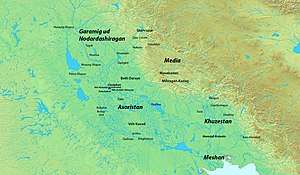
After the capture of Dastagird, the son of Khosrow, Sheroe, was released by the feudal families of the Sasanian Empire, which included: The Ispahbudhan spahbed Farrukh Hormizd and his two sons Rostam Farrokhzad and Farrukhzad. Shahrbaraz of Mihran family, the Armenian faction represented by Varaztirots II Bagratuni, and finally Kanadbak of the Kanārangīyān family.[40] On the night of 25 February, the night-watch of the Sasanian capital of Ctesiphon, which would usually shout the name of the reigning shah, shouted the name of Sheroe instead, which indicated a coup d'état was taking place.[41] Sheroe, with Aspad Gushnasp leading his army, captured Ctesiphon and imprisoned Khosrow II in the house of a certain Mehr-Sepand (also known as Maraspand). Sheroe, who had now assumed the dynastic name of Kavad II, then ordered Aspad Gushnasp to lead the charge of accusations against the deposed shah. Khosrow, however, dismissed all accusations one by one.[42]
Kavad shortly proceeded to have all his brothers and half-brothers executed, including the heir Mardanshah, who was Khosrow's favourite son. The murder of all his brothers, "all well-educated, valiant, and chivalrous men",[4] stripped the Sasanian dynasty of a future competent ruler, and has been described as a "mad rampage" and "reckless".[43] Three days later he ordered Mihr Hormozd to execute Khosrow. However, after the regicide of his father, Kavad also proceeded to have Mihr Hormozd killed.[44] Khosrow's daughters Boran and Azarmidokht reportedly criticized and scolded Kavad for his barbaric actions, which made him filled with remorse.[45] With the support of the Iranian nobles, Kavad then made peace with the Byzantine emperor Heraclius, which made the Byzantines regain all their lost territories, their captured soldiers, a war indemnity, along with the True Cross and other relics that were lost in Jerusalem in 614.[46][47]
Due to Kavad's actions, his reign is seen as a turning point in Sasanian history, and has been argued by some scholars as playing a key role in the fall of the Sasanian Empire.[43] The overthrow and death of Khosrow culminated in a chaotic civil war, with the most powerful members of the nobility gaining full autonomy and starting to create their own government. The hostilities between the Persian (Parsig) and Parthian (Pahlav) noble-families were also resumed, which split up the wealth of the nation.[4] The civil war finally ended when Khosrow's eight year old grandson, Yazdegerd III, ascended the throne.[48] The young king, however, inherited a disintegrating empire, which was dealt its last blow in 651 during the Arab conquest of Iran.[49]
Khosrow II in Islamic tradition
Islamic tradition tells a story in which Khosrow II (in Arabic: كسرى Transliteration: Kisra) was a Persian king to whom Muhammad had sent a messenger, Abdullah ibn Hudhafah as-Sahmi, along with a letter in which Khosrow was asked to preach the religion of Islam.[50][51] The account as transmitted by Muslim tradition reads:
"In the name of Allah, the Beneficent, the Merciful. From Muhammad, the Messenger of Allah, to Kisra, the great (leader/head) of the Persians. Peace be upon him, who seeks truth and expresses belief in Allah and in His Prophet and testifies that there is no god but Allah and that He has no partner, and who believes that Muhammad is His servant and Prophet. Under the Command of Allah, I invite you to Him. He has sent me for the guidance of all people so that I may warn them all of His wrath and may present the unbelievers with an ultimatum. Embrace Islam so that you may remain safe (in this life and the next). And if you refuse to accept Islam, you will be responsible for the sins of the Magi."[51][52]
Islamic tradition further states that Khosrow II tore up Muhammed's letter[53] saying, "A pitiful slave among my subjects dares writes his name before mine" [54] and commanded Badhan, his vassal ruler of Yemen, to dispatch two valiant men to identify, seize and bring this man from Hijaz (Muhammad) to him. When Abdullah ibn Hudhafah as-Sahmi told Muhammad how Khosrow had torn his letter to pieces, Muhammad promised the destruction of Khosrow II stating, "Even so, Allah shall destroy his kingdom."[53]
In art

The battles between Heraclius and Khosrow are depicted in a famous early Renaissance fresco by Piero della Francesca, part of the History of the True Cross cycle in the church of San Francesco, Arezzo. Many Persian miniature paintings depict events in his life, like his battles or his assassination.
Family
Khosrow was the son of Hormizd IV, and an unnamed Ispahbudhan noblewoman who was the sister of Vistahm and Vinduyih. Khosrow also had two cousins from the Ispahbudhan family whom were named Mah-Adhur Gushnasp and Narsi.[55] He had a brother-in-law named Hormuzan,[56] a Sasanian nobleman from one of the seven Parthian clans, who later fought against the Arabs during the Muslim invasion of Persia. However, this is most likely wrong since Kavad's mother was a Byzantine princess named Maria.[57]
Khosrow married three times: first to Maria, a daughter of the Byzantine emperor Maurice, who bore him Kavad II. Then to Gordiya, the sister of Bahram Chobin, who bore him Javanshir. Then to Shirin, who bore him Mardanshah.[1] Khosrow also had other children whom were named: Borandukht, Azarmidokht, Shahriyar and Farrukhzad Khosrow V. All these persons except Shahriyar would later become the monarch of Iran during the Sasanian civil war of 628-632. Khosrow had a brother named Kavad and a sister named Mirhran, who was married to the Sasanian spahbed Shahrbaraz, and later bore him Shapur-i Shahrvaraz,[58] while Kavad married an unnamed woman who bore him Khosrow III.
Family tree
| Khosrow I (531–579) | Shapur († 580s) | ||||||||||||||||||||||||||||||||||||||||||||||||||||||||||||||||||||||||||||||||||||||||||||||||||||||
| Hormizd IV (579–590) | Unknown | Vistahm (590/1–596 or 594/5–600) | Vinduyih | Unnamed noblewoman | Jushnas | ||||||||||||||||||||||||||||||||||||||||||||||||||||||||||||||||||||||||||||||||||||||||||||||||||
| Khosrow II (590–628) | Kavad | Mirhran | Mah-Adhur Gushnasp | Narsi | |||||||||||||||||||||||||||||||||||||||||||||||||||||||||||||||||||||||||||||||||||||||||||||||||||
| Kavad II (628) | Azarmidokht (630–631) | Mardanshah († 628) | Javanshir | Khosrow III (630) | Shapur-i Shahrvaraz (630) | ||||||||||||||||||||||||||||||||||||||||||||||||||||||||||||||||||||||||||||||||||||||||||||||||||
| Kavad Gushnasp | Anoshagan | Tamahij | Bistam | ||||||||||||||||||||||||||||||||||||||||||||||||||||||||||||||||||||||||||||||||||||||||||||||||||||
| Borandukht (629–630, 631–632) | Farrukhzad Khosrow V (631) | Shahriyar († 628) | Unknown | ||||||||||||||||||||||||||||||||||||||||||||||||||||||||||||||||||||||||||||||||||||||||||||||||||||
See also
| Wikimedia Commons has media related to Khosrau II. |
- Babai the Great
- Behistun Inscription
- Behistun Palace
- Kisra legend, an African migration myth that historian Leo Frobenius argued was based on Khosrow II
- Muqawqis, Ruler of Alexandria
- Non-Muslim interactants with Muslims during Muhammad's era
- Shabdiz Khosrow's highly admired horse
- Ganj-e Badavard
References
- Howard-Johnston 2010.
- Skjærvø 2000; Nicholson, Canepa & Daryaee 2018
- Nicholson, Canepa & Daryaee 2018.
- Shahbazi 2004, pp. 466-467.
- Hansman 1986, pp. 277-278.
- Shahbazi 1988, pp. 514–522.
- Rezakhani 2017, p. 178.
- Kia 2016, p. 241.
- Greatrex & Lieu 2002, p. 172.
- Greatrex & Lieu 2002, p. 173.
- Martindale, Jones & Morris 1992, p. 251.
- Rawlinson 2004, p. 509.
- Greatrex & Lieu 2002, p. 174.
- Pourshariati 2008, pp. 128-129.
- Pourshariati 2008, p. 129.
- Kia 2016, p. 242.
- Shapur Shahbazi 1989, p. 180–182.
- Pourshariati 2008, pp. 131–132.
- Pourshariati 2008, pp. 132, 134.
- Pourshariati 2008, pp. 132–133, 135.
- Pourshariati 2008, pp. 133–134.
- Pourshariati 2008, pp. 136–137.
- Peter Brown: The Rise of Western Christendom. 2. erweiterte Auflage. Oxford 2003, S. 283.
- Frye 1983, p. 166.
- Frye 1983, p. 171.
- Frye 1983, p. 172.
- Landau-Tasseron, Ella. "ḎŪ QĀR". ENCYCLOPÆDIA IRANICA. Retrieved 8 January 2012.
- Richard Nelson Frye, The History of Ancient Iran, p 330.
- Sebeos, chapter 24
- Kia 2016, p. 223.
- Greatrex & Lieu 2005, p. 197.
- Howard-Johnston 2006, p. 33.
- Foss 1975, p. 725
- Kaegi 2003, p. 88
- Martindale, Jones & Morris (1992), pp. 1363–1364
- Pourshariati 2008, pp. 153–154.
- Soudavar, Abolala. "Looking through The Two Eyes of the Earth: A Reassessment of Sasanian Rock Reliefs" (PDF). www.soudavar.com.
- Pourshariati 2008, pp. 152–153.
- Kaegi 2003, p. 140.
- Pourshariati 2008, p. 173.
- Morony 2005, p. 92.
- Tafazzoli 1987, p. 743.
- Kia 2016, pp. 255-256.
- Al-Tabari 1999, pp. 398.
- Al-Tabari 1985–2007, v. 5: p. 399.
- Oman 1893, p. 212
- Kaegi 2003, pp. 178, 189–190
- Pourshariati 2008, p. 219.
- Kia 2016, pp. 284-285.
- al-Mubarakpuri (2002) p. 417
- "Chapter 42: The Events of the Seventh Year of Migration". Archived from the original on 5 August 2012. Retrieved 25 August 2013.
- Tabaqat-i Kubra, vol. I, page 360; Tarikh-i Tabari, vol. II, pp. 295, 296; Tarikh-i Kamil, vol. II, page 81 and Biharul Anwar, vol. XX, page 389
- Kisra, M. Morony, The Encyclopaedia of Islam, Vol. V, ed.C.E. Bosworth, E.van Donzel, B. Lewis and C. Pellat, (E.J.Brill, 1980), 185.
- Mubarakpuri, Safiur-Rahman. WHEN THE MOON SPLIT. Darussalam. ISBN 978-603-500-060-4.
- Pourshariati 2008, p. 179.
- electricpulp.com. "HORMOZĀN – Encyclopaedia Iranica".
- Pourshariati 2008, p. 236.
- Pourshariati 2008, p. 205.
Sources
- Baca, Winters, Keenan. He Did Not Fear: Xusro Parviz, King of Kings of the Sasanian Empire. Gorgias Press, 2019. ISBN 978-1-4632-3927-5
- Baca-Winters, Keenan. "From Rome to Iran: Identity and Xusro II." PhD. diss., University of California, Irvine, 2015. https://escholarship.org/uc/item/1rp8c11b
- Meyer, Eduard (1911). . In Chisholm, Hugh (ed.). Encyclopædia Britannica (11th ed.). Cambridge University Press.
- Edward Walford, translator, The Ecclesiastical History of Evagrius: A History of the Church from AD 431 to AD 594, 1846. Reprinted 2008. Evolution Publishing, ISBN 978-1-889758-88-6. — a primary source containing detailed information about the early reign of Khosrow II and his relationship with the Romans.
- Foss, Clive (1975), "The Persians in Asia Minor and the End of Antiquity", The English Historical Review, Oxford University Press, 90: 721–47, doi:10.1093/ehr/XC.CCCLVII.721.
- Frye, R. N. (1983), "Chapter 4", The political history of Iran under the Sasanians, The Cambridge History of Iran, 3, Cambridge University Press, ISBN 978-0-521-20092-9
- Greatrex, Geoffrey; Lieu, Samuel N. C. (2005). The Roman Eastern Frontier and the Persian Wars AD 363-628. Routledge. ISBN 978-1-134-75646-9.CS1 maint: ref=harv (link)
- Howard-Johnston, James (2006), East Rome, Sasanian Persia And the End of Antiquity: Historiographical And Historical Studies, Ashgate Publishing, ISBN 0-86078-992-6.
- Howard-Johnston, James (2010). "ḴOSROW II". Encyclopaedia Iranica, Online Edition. Retrieved 9 November 2013.CS1 maint: ref=harv (link)
- Kia, Mehrdad (2016). he Persian Empire: A Historical Encyclopedia [2 volumes]: A Historical Encyclopedia. ABC-CLIO. ISBN 978-1-61069-391-2.CS1 maint: ref=harv (link)
- Martindale, John Robert; Jones, Arnold Hugh Martin; Morris, J., eds. (1992). The Prosopography of the Later Roman Empire, Volume III: A.D. 527–641. Cambridge: Cambridge University Press. ISBN 978-0-521-20160-5.
- Morony, Michael G. (2005). Iraq After the Muslim Conquest. Piscataway, New Jersey: Gorgias Press. ISBN 978-15-93333-15-7.CS1 maint: ref=harv (link)
- Nicholson, Oliver; Canepa, Matthew; Daryaee, Touraj (2018). "Khosrow I Anoshirvan". In Nicholson, Oliver (ed.). The Oxford Dictionary of Late Antiquity. Oxford: Oxford University Press. ISBN 978-0-19-866277-8.CS1 maint: ref=harv (link)
- Pourshariati, Parvaneh (2008). Decline and Fall of the Sasanian Empire: The Sasanian-Parthian Confederacy and the Arab Conquest of Iran. London and New York: I.B. Tauris. ISBN 978-1-84511-645-3.CS1 maint: ref=harv (link)
- Kaegi, Walter Emil (2003). Heraclius: Emperor of Byzantium. Cambridge, United Kingdom: Cambridge University Press. ISBN 0-521-81459-6.CS1 maint: ref=harv (link)
- Shahbazi, A. Shapur (1988). "Bahram VI Cobin". Encyclopaedia Iranica, Vol. III, Fasc. 5. London et al.: Encyclopaedia Iranica. pp. 514–522.CS1 maint: ref=harv (link)
- Shahbazi, A. Shapur (2004). The Authoritative Guide to Persepolis. Tehran: Sanaye Farhangi Iran (SAFIR). pp. 466–467. ISBN 978-96-49196-05-3.CS1 maint: ref=harv (link)
- Shapur Shahbazi, A. (2005). "Sasanian dynasty". Encyclopaedia Iranica, Online Edition. Retrieved 30 March 2014.CS1 maint: ref=harv (link)
- Shapur Shahbazi, A. (1989). "BESṬĀM O BENDŌY". Archived copy. Encyclopaedia Iranica, Vol. IV, Fasc. 2. pp. 180–182. Archived from the original on 22 September 2013. Retrieved 13 August 2013.CS1 maint: ref=harv (link) CS1 maint: archived copy as title (link)
- Skjærvø, Prods Oktor (2000). "Kayāniān vii. Kauui Haosrauuah, Kay Husrōy, Kay Ḵosrow". Encyclopaedia Iranica.CS1 maint: ref=harv (link)
- Greatrex, Geoffrey; Lieu, Samuel N. C. (2002). The Roman Eastern Frontier and the Persian Wars (Part II, 363–630 AD). New York, New York and London, United Kingdom: Routledge (Taylor & Francis). ISBN 0-415-14687-9.CS1 maint: ref=harv (link)
- Crawford, Peter (2013). The War of the Three Gods: Romans, Persians and the Rise of Islam. Pen and Sword. ISBN 978-1-84884-612-8.CS1 maint: ref=harv (link)
Khosrow II Sasanian dynasty | ||
| Preceded by Hormizd IV |
Great King (Shah) of Ērānshahr 590 |
Succeeded by Bahram Chobin |
| Preceded by Bahram Chobin |
Great King (Shah) of Ērānshahr 591–628 |
Succeeded by Kavad II |
